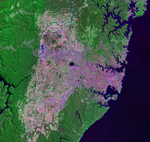Castle Hill convict rebellion

The Castle Hill convict rebellion was an 1804 convict rebellion in the Castle Hill area of Sydney, against the colonial authorities of the British colony of New South Wales. Led by veterans of the United Irish Rebellion of 1798, the poorly armed insurgents confronted the colonial forces of Australia on 5 March 1804 at Rouse Hill. Their rout in the resulting skirmish was hailed by loyalists as Australia's Vinegar Hill after the 1798 Irish Battle of Vinegar Hill, where rebels in Ireland were decisively defeated. The incident was the first major convict uprising in Australian history to be suppressed under martial law. On 4 March 1804, 233 convicts, led by Philip Cunningham, a veteran of the 1798 rebellion, as well as a mutineer on the convict transport ship Anne, escaped from a prison farm, intent on "capturing ships to sail to Ireland". In response, martial law was quickly declared in the colony. The mostly Irish rebels, having gathered reinforcements, were hunted by the colonial forces until they were caught on Rouse Hill on 5 March 1804. While negotiating under a flag of truce, Cunningham was arrested. The troops then charged, and the rebellion was suppressed. Nine of the rebel leaders were executed, and hundreds were punished, before martial law was revoked a week after the battle.
Excerpt from the Wikipedia article Castle Hill convict rebellion (License: CC BY-SA 3.0, Authors, Images).Castle Hill convict rebellion
Pennant Way, Sydney Castle Hill
Geographical coordinates (GPS) Address Nearby Places Show on map
Geographical coordinates (GPS)
| Latitude | Longitude |
|---|---|
| N -33.7293 ° | E 151.004 ° |
Address
Pennant Way
Pennant Way
2154 Sydney, Castle Hill
New South Wales, Australia
Open on Google Maps







